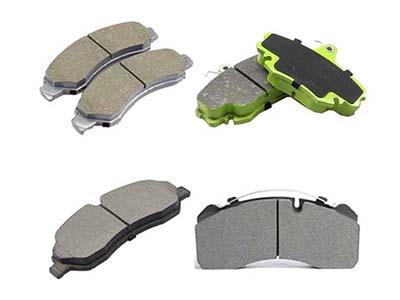Materials of brake pads.
The main materials of automobile brake pads are metal-based materials and friction materials. The structure is generally composed of steel plates, adhesive insulation layers and friction blocks.
Metal-based materials usually include steel, copper, aluminum, etc., which play a supporting and heat-conducting role. Among them, the insulation layer is composed of materials that do not transfer heat, and the purpose is heat insulation. The friction block is composed of friction materials and adhesives. The friction material is the main part of the brake pad. It needs to have good wear resistance, heat resistance and friction reduction to provide sufficient friction during braking. When braking, it is squeezed on the brake disc or brake drum to produce friction, thereby achieving the purpose of vehicle deceleration and braking. Due to friction, the friction block will gradually be worn. Generally speaking, the lower the cost of the brake pad, the faster it will wear. At present, the friction materials in automobile brake pads are usually semi-metallic or ceramic materials, which have high wear resistance and heat resistance. In addition, some brake pads will also add fiber materials to improve strength and heat resistance.

The type of brake pads.
The common friction materials on the market are: semi-metallic materials and ceramic materials.
1) Semi-metallic brake pads
Semi-metallic brake pads contain metal fibers (such as iron, steel, copper, etc.) and non-metallic fillers. Advantages:
①Good heat dissipation, suitable for high-performance driving.
②Strong wear resistance and long service life.
③Stable braking effect.
Disadvantages:
①Large braking noise.
②Great wear on the brake disc.
③Produces more dust.
2) Low-metal brake pads
Low-metal brake pads contain a small amount of iron, generally steel wool and iron powder, which is a kind of semi-metal.
Advantages:
①. Low noise, less noise during emergency braking, suitable for urban driving.
②. Less wear on the brake disc. The huge friction generated during braking often causes wear on the brake disc. The low-metal brake pad is relatively soft, and the friction has a greater impact on itself, but less wear on the brake disc.
③The cost is relatively low and the price is relatively cheap. It is a good choice for people with a low budget.
Disadvantages:
①Poor heat resistance. It may have an adverse effect on the braking effect under extremely high temperatures.
② The material is relatively soft and has a short service life.
③ It is easy to generate dust.
Ceramic brake pads use special ceramic composite materials. Its material is mainly composed of a combination of mineral fibers, aramid fibers and ceramic fibers.
Advantages:
① Excellent braking performance, especially at high temperatures.
② Extremely low noise, suitable for comfortable driving.
③ Friendly to brake discs and reduces wear.
Disadvantages:
① The cost of ceramic brake pads is relatively high,
② Poor wear resistance and need to be replaced more frequently.













